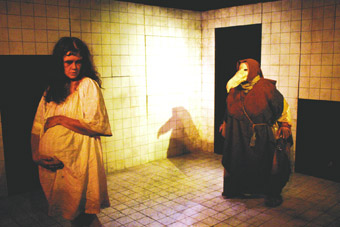fabulous liars
douglas leonard: restaged histories project, the greater plague

The Greater Plague (2005 production), The Restaged Histories project
photo Andy Miller
The Greater Plague (2005 production), The Restaged Histories project
TWO TRANSPARENT PLASTIC SCREENS PARTITION THE STAGE. WITH LIGHTS, THEY ARE TRANSFORMED INTO DIM CORRIDORS TRAVERSED BY SEMI-NOCTAMBULAR BEINGS. IN A SCENARIO REMINISCENT OF CREEPY MOVIES, A MODERN DAY PREGNANT YOUNG WOMAN AND HER TEENAGE SISTER ARRIVE AT A HOUSE, UNCLEAR WHY THEY ARE THERE, DRAWN BY A SINISTER NURSE AND OLEAGINOUS JANITOR INTO A MIASMA OF SADISTIC, HISTORICAL GAMES.
The house doubles as a plague house from 17th century Europe which held people suspected of being infected by the plague for 40 days, after which they would either have succumbed or been set free. But often inmates went mad from fear and paranoia in any event. As a mis-en-abyme, the house incorporates the past, the present and the future, not least in terms of the theatrical spin given our own so-called post-dramatic situation. The Restaged Histories project’s production of The Greater Plague is not history. It’s a perversely ludic riff.
For most of us, in any case, history is not remotely veridical, but consists of wildly denoted pictures in our heads mediated by Hollywood or flickering newsreels. The equivalent 19th century mediators of historical and current events were the music halls and the penny arcades, a program reference to performing venues which were holes in the wall catering to the poorest audiences. The Greater Plague revives this tradition in a series of set pieces conjured up by the house’s agents. The janitor as a parodic Jolly Jack Tar, draped in the Union Jack, travels the world in pantomine while Ur-asian women posture and solicit behind him. Illness strikes and he heads for home and safety. Unbeknownst to him, the plague (sexual?) comes too. A family of Restoration-costumed mechanical dolls enact a history of sexual licence and abuse involving all the generations and a corrupted genealogy of dangerous liaisons for the pregnant woman.
Another abusive family of pig-breeders, murderous, bestial and deformed in swinish fat suits, provides the back story for the starched and sterile nurse (Ratchett?). In a more contemporary version of the penny arcade, the younger sister of the pregnant woman hams it up, doing a karaoke rendition of Whitney Huston’s “I Will Always Love You” as an expression of her misplaced adolescent feelings for the misogynistic, inarticulate and violent janitor who is also a practising necrophiliac, in love, so to say, with death.
Humanity appears almost without exception execrable or, at the very least, wretched. Admittedly, this is through the lens of ironic, comical, deliberately ludicrous Gothicism that delights in its own dark excesses. It can’t be taken seriously, or can it? What are the connotations of The Greater Plague that transcend the actual epoch of The Great Plague? Given the nasty sexual undertones, I suggest it means something like Wilhelm Reich’s emotional plague that he declared endemic down through history.
Beset by rules and regulations represented by conventions in the theatre, the Restaged Histories project takes lovely liberties, and at least one character refuses to play her role. According to Bataille, evil does not negate but rather completes human nature, hence the necessary transgressive nature of art embodied in her gesture. The formidable performance ensemble—Jonathan Brand, Morgan French, Emma Pursey, Emily Tomlins—supported this gesture like a gloved hand. But this sort of reductive speculation is redundant in terms of the apparent anti-aesthetic espoused in the production. It didn’t progress according to the beginning, middle and end of telling a story, but instead digressed in ways that foregrounded a proliferation of meanings. The company’s democratically inclined notion of theatre also drew on a variety of redeployable theatrical means gone into overdrive—from the janitor’s malign clowning to the surreal pantomimes to the pregnant woman’s high melodramatic hysteria. There was Brecht in there, but a distinctively postmodern Brecht.
The Greater Plague was not without flaws. Despite its Gothic vitality, it often lumbered and seemed to run out of oomph a good 10 minutes before it ended. The screens, so good in combination with Carolyn Emerson’s atmospheric lighting in establishing an initial, cinematic mood, contributed however to a flattening of affect. They distanced the audience from the performers, appropriately enough at times in the penny arcades, but otherwise denied us a way in to the core of the performance, or any real intimacy with the physical reality of the performers. Effectively, we were screened out. This feeling of exclusion can irritate an audience more than anything else in theatre (more than proliferations of meanings!). The karaoke went on too long. We got the point. And the screens muffled the voices. Sometimes I found myself tuning out and listening to Steve Toulmiin’s subtly crafted soundscape instead.
The Restaged Histories project is by Nic Dorward and Kieran Swan. The Greater Plague at Brisbane Powerhouse was their own restaged version of a work first presented at Metro Arts in 2005. Since then they have received support from Brisbane Powerhouse Artists-in-Residence and MAPS for Artists programs so the production came weighted with expectations. If it didn’t quite defy the tilt, Dorward and Swann are a new generation of fabulous liars in a mundane world where, as perhaps the show problematises, the vanguard is now funded by the state.
The Restaged Histories project (Nic Dorward, Kieran Swann), The Greater Plague, performers, Jonathon Brand, Morgan French, Emma Pursey, Emily Tomlins, lighting Carolyn Emerson, composer, sound designer, Steve Toulmiin; Brisbane Powerhouse, April 22-May 2
RealTime issue #91 June-July 2009 pg. 43






